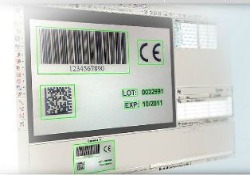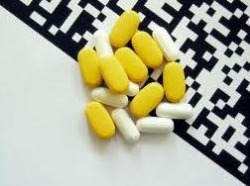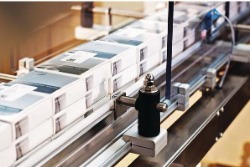Falsified, counterfeit or unauthorized medicines are finding their way into the legitimate supply chain in the EU. These medicines are often dangerous to the patient and are costing legitimate manufacturers millions, if not billions of Euro every year. To address this problem the EU adopted the FMD (2011/62/EU) directive in July 2011, with compliance to be enforced in 2016. The FMD directive incorporates a number of initiatives to safeguard the pharmaceutical supply chain in Europe. Among these are “safety features” for all medicines entering the supply chain in the EU, while also stating “Those safety features should allow verification of the authenticity and identification of individual packs, and provide evidence of tampering”. While the directive does not stipulate the identification technology for the ‘safety features’, it is highly likely that Datamatrix ECC200 2D barcode technology will be the choice of most countries.
Datamatrix ECC200 is now common place in the pharmaceutical industry. Printing, coding and scanning technology capable of handling ECC200, is widely available and already in place in many productions lines. AIS ltd supply, install and maintain the full range of Datamatrix barcode printing and scanning technologies. Our engineers have years of experience in both the technologies involved, the international standards governing barcode print quality and regional requirements which differ from country to country.
Numbering alone is not enough – The preferred way of dealing with the increasing number of counterfeit medicines and meeting  new regulations is to secure the supply chain of individual drug packages with the help of technology. As a first step, item serialisation (individual numbering at item level with a unique and tamper-proof ID) has evolved over the last few years as the technology of choice. There is not a single large drug company today that does not take serialisation seriously – and act accordingly. Tracking and tracing task forces and project teams have been set up, pilot lines built and – in case the company happens to serve regions that are already affected (e. g. France with CIP13 coding or Turkey with coding for both serialisation and aggregation) – actual production lines equipped to manufacture single item-numbered products.
new regulations is to secure the supply chain of individual drug packages with the help of technology. As a first step, item serialisation (individual numbering at item level with a unique and tamper-proof ID) has evolved over the last few years as the technology of choice. There is not a single large drug company today that does not take serialisation seriously – and act accordingly. Tracking and tracing task forces and project teams have been set up, pilot lines built and – in case the company happens to serve regions that are already affected (e. g. France with CIP13 coding or Turkey with coding for both serialisation and aggregation) – actual production lines equipped to manufacture single item-numbered products.
Both the EU and the US would like to establish the universal GS1 standard for item level numbering in combination with Data Matrix (2D barcode) coding, with effective dates as late as 2014 and 2015. And although it will represent a major step forward in terms of standardisation, the legislation proposed in the EU is currently no more than a directive which does not tell the industry exactly what it needs to be prepared for – or when. Whereas some regions only require item level serialisation with an individual number printed on each package, other countries go one step further. They insist on aggregation, where hierarchical information that is generated whenever items are packed into bundles or cartons and on pallets is linked together and stored accordingly. This clearly affects the technological requirements relating on the one hand to data handling and on the other to the interfacing between the individual steps in the packaging process.
Despite the above-mentioned variability and uncertainties, the industry acknowledges that serialisation is “here to stay”. The  challenge is to establish a serialisation infrastructure that goes beyond the mere numbering of an individual package. Global, comprehensive and secure handling of packaging data should not only comply with various serialisation requirements but also increase supply chain efficiency. There are three key aspects that need to be considered.
challenge is to establish a serialisation infrastructure that goes beyond the mere numbering of an individual package. Global, comprehensive and secure handling of packaging data should not only comply with various serialisation requirements but also increase supply chain efficiency. There are three key aspects that need to be considered.
1 – Technical Solution
Standardisation can provide the answer here. However, since this would appear to conflict with the desired variability, what the industry really needs is a solution that enables it to switch from a “wait-and-see” attitude to “wait and be prepared”. Technical concepts should preferably be built around standard components and functions while offering the necessary adaptability to meet requirements that are as yet unknown. Flexibility and modularity are vital. Highly standardised, tested and modular components that support fast and versatile implementation are a must for any company endeavouring to implement a serialisation infrastructure in its packaging processes in a harmonised, cost-effective and efficient way yet still be in a position to respond to upcoming or changing regulatory requirements.
2 – Organisation
In addition to the right technical solution there is also a growing awareness in the industry that a truly global rollout is impossible without a supplier that is capable of handling such an implementation. Building a pilot line is one thing – managing a rollout of sixty lines in four different regions, with three different levels of aggregation and a time frame of just eighteen months, calls for an altogether different approach.
The side-effects of serialisation should not be underestimated. The fact that in most cases introducing a serialisation solution will affect existing packaging lines and workflows means that production managers often adopt a critical attitude when examining the planned changes and the likely repercussions for the overall equipment effectiveness (OEE) of their packaging lines – not to mention the negative impact on current production. Choosing a supplier that takes such misgivings seriously and is used to working in a validated, critical environment like AIS will help reduce the potential risks and, in the end, lower the cost of implementing the serialisation solution.
In the light of all these restrictions and challenges, the industry is on the lookout for partners rather than just suppliers. What is wanted are organisations that are willing to assume responsibility for the successful implementation of their serialisation platforms – regardless of the location, size, level, technology and number of subcontractors.
3 – Cost effectiveness
At the moment, the industry tends to see item level serialisation as yet another obligatory regulatory hurdle – one that will simply  add to the enormous amount of money already spent annually on keeping pace with a variety of regulations around the globe. Manufacturers and regulators will only really be in a position to tackle the problems associated with counterfeit medicines with initiatives that cover the entire supply chain right the way down to the sale or care point.
add to the enormous amount of money already spent annually on keeping pace with a variety of regulations around the globe. Manufacturers and regulators will only really be in a position to tackle the problems associated with counterfeit medicines with initiatives that cover the entire supply chain right the way down to the sale or care point.
There are other ways of looking at this, however. Item level serialisation can contribute to overall supply chain optimisation – as one way to deal with the business related issues mentioned earlier. Interesting replies gathered during a case study revealed that acceptance of serialisation as an anti-counterfeit measure would increase if, in addition to compliance with regulations, the improvements would also save money by making the supply chain more transparent.
In order to exploit these opportunities and make serialisation a chance to be seized rather than a mandatory must-do, all the above conditions need to be met: a standardised solution using standardised components, yet configurable with the maximum possible flexibility and modularity and offered in combination with a service level that enables a true global rollout and lifecycle support. Only by forging partnerships with suppliers like AIS that fulfil the above requirements will the industry be able to cope with the wave of serialisation that is already looming on the horizon – and leverage the potential for supply chain optimisation that lies underneath.
If you are responsible for Serialisation in your organisation, contact AIS on 353 1 6205742 to discuss options available to you.